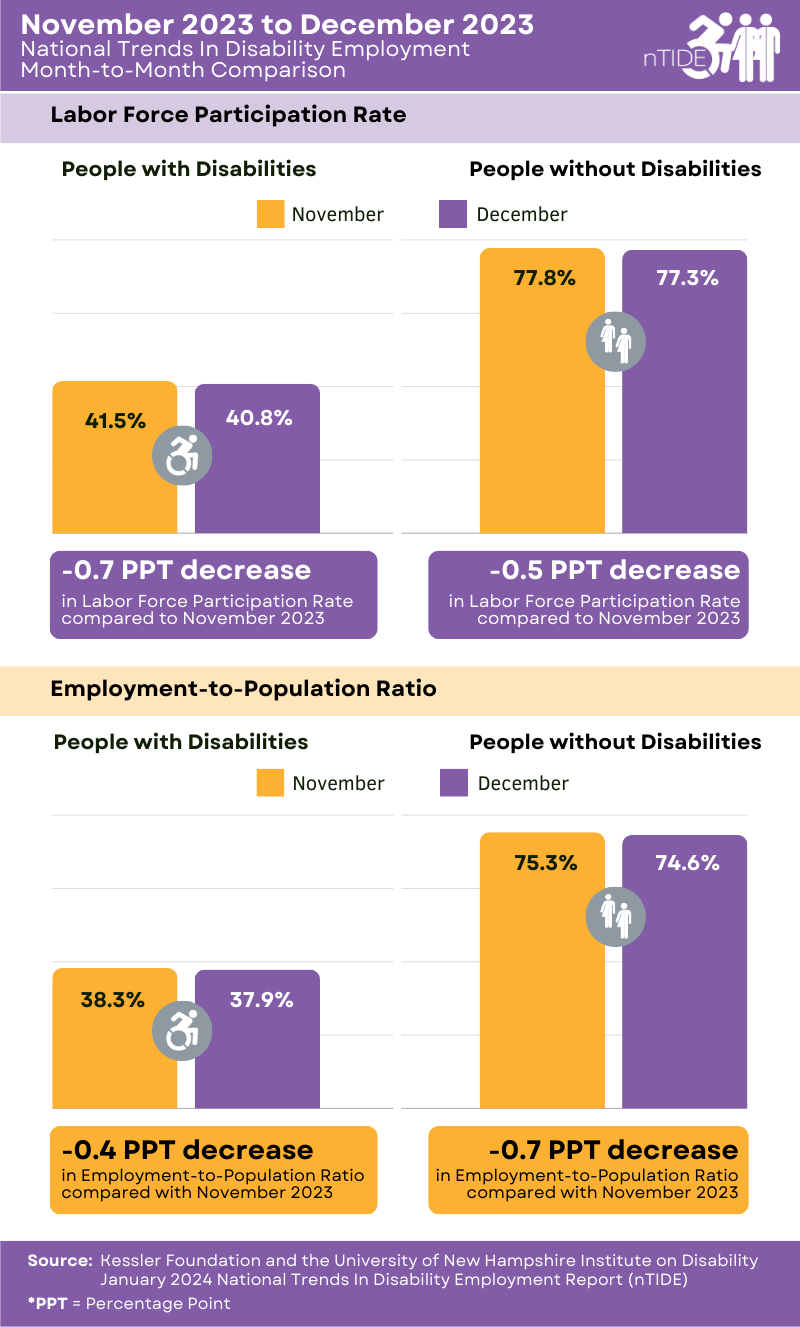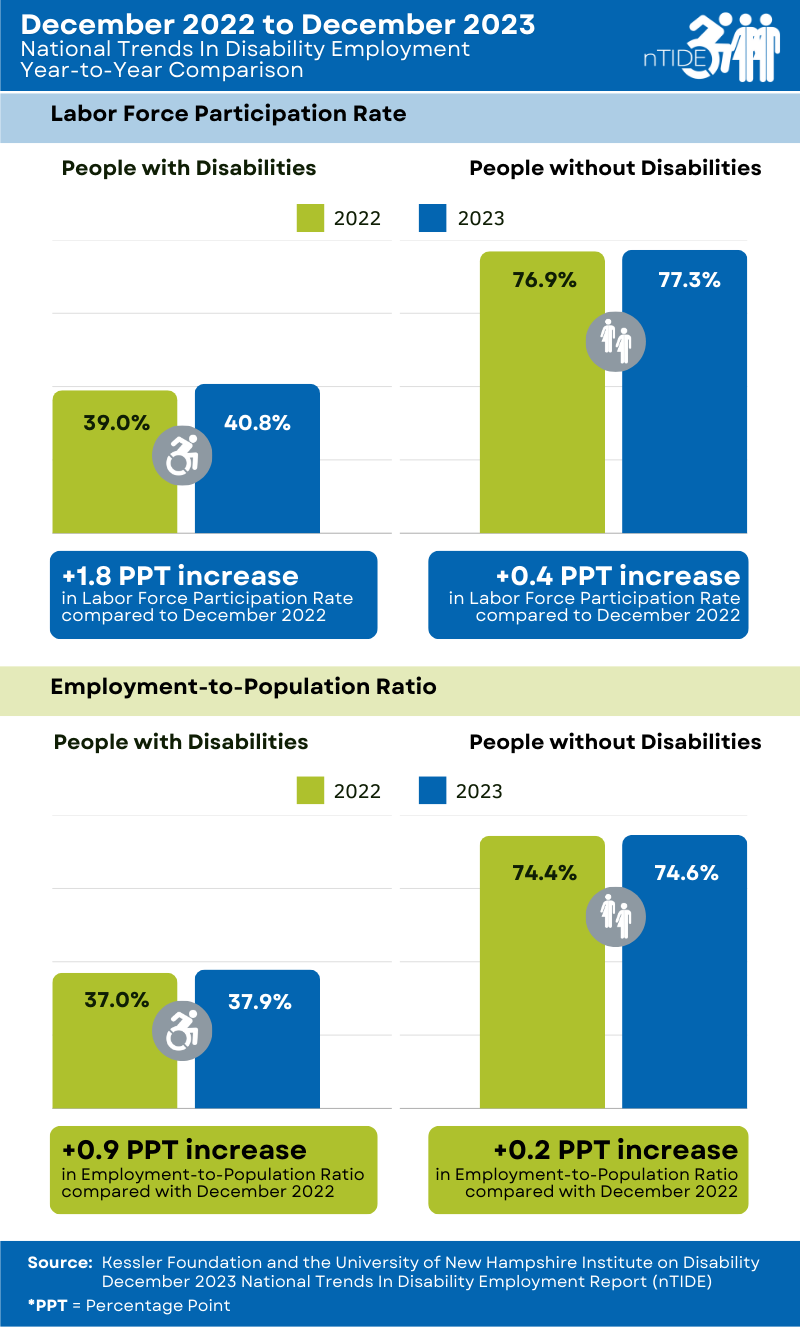National Trends in Disability Employment (nTIDE) – Issued semi-monthly by Kessler Foundation and the University of New Hampshire.
East Hanover, NJ – January 5, 2023 – Following a historic high in November, slight declines were seen in the employment-to-population ratio and the labor force participation rate in December 2023 for people with and without disabilities. However, numbers still remain near the record levels achieved the previous month, according to today’s National Trends in Disability Employment – semi-monthly update (nTIDE), issued by Kessler Foundation and the University of New Hampshire’s Institute on Disability (UNH-IOD).
Month-to-Month nTIDE Numbers (comparing November 2023 to December 2023)
Based on data from the U.S. Bureau of Labor Statistics (BLS) Jobs Report released today, the employment-to-population ratio for people with disabilities (ages 16-64) decreased from 38.3 percent in November 2023 to 37.9 percent in December 2023 (down 1 percent or 0.4 percentage points). For people without disabilities (ages 16-64), the employment-to-population ratio decreased from 75.3 percent in November 2023 to 74.6 percent in December 2023 (down 0.9 percent or 0.7 percentage points). The employment-to-population ratio, a key indicator, reflects the percentage of people who are working relative to the total population (the number of people working divided by the number of people in the total population multiplied by 100).

“In December, the employment-to-population ratio for individuals with disabilities dipped slightly, contrasting with the relatively substantial rise seen in the previous month,” according to John O’Neill, PhD, director of the Center for Employment and Disability Research at Kessler Foundation. “Nevertheless, the employment of people with disabilities remains near all-time highs,” added Dr. O’Neill.
Similarly, the labor force participation rate for people with disabilities (ages 16-64) decreased from 41.5 percent in November 2023 to 40.8 percent in December 2023 (down 1.7 percent or 0.7 percentage points). For people without disabilities (ages 16-64), the labor force participation rate decreased from 77.8 percent in November 2023 to 77.3 percent in December 2023 (down 0.6 percent or 0.5 percentage points). The labor force participation rate reflects the percentage of people who are in the labor force (working, on temporary layoff (on furlough), or actively looking for work in the last four weeks) relative to the total population (the number of people in the labor force divided by the number of people in the total population multiplied by 100).
“Despite the December decline, the labor force participation of people with disabilities has held fairly steady – around 40 percent – throughout the last half of 2023,” said Andrew Houtenville, PhD, professor of economics and research director of the UNH-IOD. “Stay tuned for the nTIDE 2023 Year-in-Review, which will be released during the mid-month nTIDE Deeper Dive on January 19, 2024.”
Year-to-Year nTIDE Numbers (comparing December 2022 to December 2023)
Compared to this time last year, the employment-to-population ratio for people with disabilities (ages 16-64) increased from 37 percent in December 2022 to 37.9 percent in December 2023 (up 2.4 percent or 0.9 percentage points). For people without disabilities (ages 16-64), the employment-to-population ratio also increased from 74.4 percent in December 2022 to 74.6 percent in December 2023 (up 0.3 percent or 0.2 percentage points).
Likewise, the labor force participation rate for people with disabilities (ages 16-64) increased from 39 percent in December 2022 to 40.8 percent in December 2023 (up 4.6 percent or 1.8 percentage points). For people without disabilities (ages 16-64), the labor force participation rate also increased from 76.9 percent in December 2022 to 77.3 percent in December 2023 (up 0.5 percent or 0.4 percentage points).
In December, among workers ages 16-64, the 6,413,000 workers with disabilities represented 4.3 percent of the total 149,715,000 workers in the U.S.

Join Us to Ask Questions about Disability and Employment
Each nTIDE release is followed by an nTIDE Lunch & Learn online webinar. This live broadcast, hosted via Zoom Webinar, offers attendees Q&A on the latest nTIDE findings, provides news, updates from the field, and features invited panelists who discuss current disability-related findings and events.
On January 5, 2023, at 12:00 pm – 1:00 pm Eastern, Drs. O’Neill and Houtenville will discuss the latest nTIDE report, Dr. Houtenville will cover potential changes to how people with disabilities are identified in surveys, and Denise Rozell, Director of Policy Innovation, AUCD, will offer announcements from the field of disability employment. Join our free Lunch & Learn live or visit the nTIDE archives at: ResearchonDisability.org/nTIDE.
Also, mark your calendars to join us for the “nTIDE 2023 Year-in-Review,” which will be released January 19, 2024, during our mid-month nTIDE Deeper Dive.
NOTE: The statistics in the nTIDE are based on BLS numbers but are not identical. They are customized by UNH to combine the statistics for men and women of working age (16- 64). nTIDE is funded by the National Institute on Disability, Independent Living and Rehabilitation Research (NIDILRR; 90RTGE0005) and Kessler Foundation.
About nTIDE Updates
National Trends in Disability Employment (nTIDE) is a joint project of Kessler Foundation and the University of New Hampshire Institute on Disability. The nTIDE team closely monitors the job numbers, issuing semi-monthly reports that track the impact of economic shifts on employment for people with and without disabilities. As the effect of the COVID-19 pandemic continues to wane and inflation persistently rises, the nTIDE team has superseded its mid-month COVID Update to a “Deeper Dive” into the BLS data for people with disabilities.
About the Institute on Disability at the University of New Hampshire
The Institute on Disability at the University of New Hampshire was established in 1987 to provide a university-based focus for the improvement of knowledge, policies, and practices related to the lives of persons with disabilities and their families. For information on the Intitute’s NIDILRR-funded Rehabilitation Research and Training Center on Disability Statistics and Demographics (StatsRRTC), visit ResearchOnDisability.org
About Kessler Foundation
Kessler Foundation, a major nonprofit organization in the field of disability, is a global leader in rehabilitation research. Our scientists seek to improve cognition, mobility, and long-term outcomes, including employment, for adults and children with neurological and developmental disabilities of the brain and spinal cord including traumatic brain injury, spinal cord injury, stroke, multiple sclerosis, and autism. Kessler Foundation also leads the nation in funding innovative programs that expand opportunities for employment for people with disabilities.